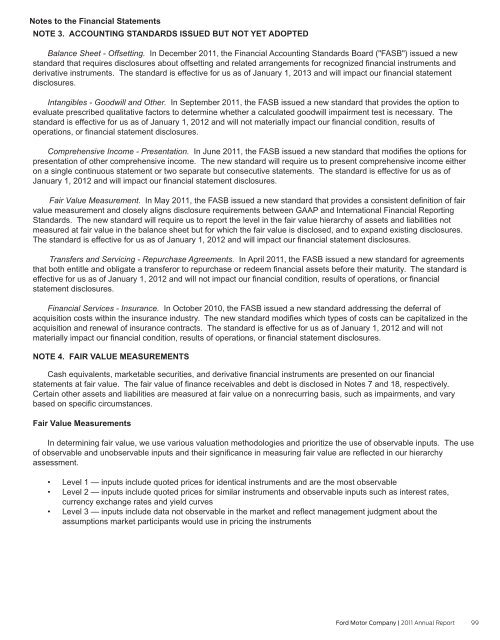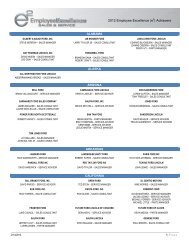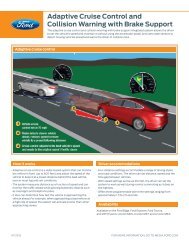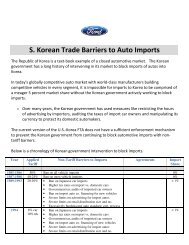Annual Report 2011 - Ford Motor Company
Annual Report 2011 - Ford Motor Company
Annual Report 2011 - Ford Motor Company
You also want an ePaper? Increase the reach of your titles
YUMPU automatically turns print PDFs into web optimized ePapers that Google loves.
Notes to the Financial Statements<br />
NOTE 3. ACCOUNTING STANDARDS ISSUED BUT NOT YET ADOPTED<br />
Balance Sheet - Offsetting. In December <strong>2011</strong>, the Financial Accounting Standards Board ("FASB") issued a new<br />
standard that requires disclosures about offsetting and related arrangements for recognized financial instruments and<br />
derivative instruments. The standard is effective for us as of January 1, 2013 and will impact our financial statement<br />
disclosures.<br />
Intangibles - Goodwill and Other. In September <strong>2011</strong>, the FASB issued a new standard that provides the option to<br />
evaluate prescribed qualitative factors to determine whether a calculated goodwill impairment test is necessary. The<br />
standard is effective for us as of January 1, 2012 and will not materially impact our financial condition, results of<br />
operations, or financial statement disclosures.<br />
Comprehensive Income - Presentation. In June <strong>2011</strong>, the FASB issued a new standard that modifies the options for<br />
presentation of other comprehensive income. The new standard will require us to present comprehensive income either<br />
on a single continuous statement or two separate but consecutive statements. The standard is effective for us as of<br />
January 1, 2012 and will impact our financial statement disclosures.<br />
Fair Value Measurement. In May <strong>2011</strong>, the FASB issued a new standard that provides a consistent definition of fair<br />
value measurement and closely aligns disclosure requirements between GAAP and International Financial <strong>Report</strong>ing<br />
Standards. The new standard will require us to report the level in the fair value hierarchy of assets and liabilities not<br />
measured at fair value in the balance sheet but for which the fair value is disclosed, and to expand existing disclosures.<br />
The standard is effective for us as of January 1, 2012 and will impact our financial statement disclosures.<br />
Transfers and Servicing - Repurchase Agreements. In April <strong>2011</strong>, the FASB issued a new standard for agreements<br />
that both entitle and obligate a transferor to repurchase or redeem financial assets before their maturity. The standard is<br />
effective for us as of January 1, 2012 and will not impact our financial condition, results of operations, or financial<br />
statement disclosures.<br />
Financial Services - Insurance. In October 2010, the FASB issued a new standard addressing the deferral of<br />
acquisition costs within the insurance industry. The new standard modifies which types of costs can be capitalized in the<br />
acquisition and renewal of insurance contracts. The standard is effective for us as of January 1, 2012 and will not<br />
materially impact our financial condition, results of operations, or financial statement disclosures.<br />
NOTE 4. FAIR VALUE MEASUREMENTS<br />
Cash equivalents, marketable securities, and derivative financial instruments are presented on our financial<br />
statements at fair value. The fair value of finance receivables and debt is disclosed in Notes 7 and 18, respectively.<br />
Certain other assets and liabilities are measured at fair value on a nonrecurring basis, such as impairments, and vary<br />
based on specific circumstances.<br />
Fair Value Measurements<br />
In determining fair value, we use various valuation methodologies and prioritize the use of observable inputs. The use<br />
of observable and unobservable inputs and their significance in measuring fair value are reflected in our hierarchy<br />
assessment.<br />
• Level 1 — inputs include quoted prices for identical instruments and are the most observable<br />
• Level 2 — inputs include quoted prices for similar instruments and observable inputs such as interest rates,<br />
currency exchange rates and yield curves<br />
• Level 3 — inputs include data not observable in the market and reflect management judgment about the<br />
assumptions market participants would use in pricing the instruments<br />
<strong>Ford</strong> <strong>Motor</strong> <strong>Company</strong> | <strong>2011</strong> <strong>Annual</strong> <strong>Report</strong> 99









